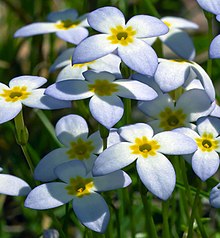bio.wikisort.org - Plant
Houstonia caerulea, commonly known as azure bluet, Quaker ladies, or bluets,[2] is a perennial species in the family Rubiaceae.[1] It is native to eastern Canada (Ontario to Newfoundland) and the eastern United States (Maine to Wisconsin, south to Florida and Louisiana, with scattered populations in Oklahoma).[3] It is found in a variety of habitats such as cliffs, alpine zones, forests, meadows and shores of rivers or lakes.[4]
| Houstonia caerulea | |
|---|---|
 | |
| Scientific classification | |
| Kingdom: | Plantae |
| Clade: | Tracheophytes |
| Clade: | Angiosperms |
| Clade: | Eudicots |
| Clade: | Asterids |
| Order: | Gentianales |
| Family: | Rubiaceae |
| Genus: | Houstonia |
| Species: | H. caerulea |
| Binomial name | |
| Houstonia caerulea | |
| Synonyms | |
| |
Description

Houstonia caerulea is a perennial herb[2] that produces showy flowers approximately 1 cm across. These flowers are four-parted with pale blue petals and a yellow center. The foliage is a basal rosette with spatula-shaped leaves.[2] Stems are up to 20 cm tall with one flower per stalk. Leaves are simple and opposite in arrangement with two leaves per node along the stem.[4] It thrives in moist acidic soils in shady areas, growing especially well among grasses.[5]
Gallery
References
- Justice, William S.; Bell, C. Ritchie; Lindsey, Anne H. (2005). Wild Flowers of North Carolina (2. printing. ed.). Chapel Hill, NC: Univ. of North Carolina Press. p. 236. ISBN 0807855979.
- "Lady Bird Johnson Wildflower Center - The University of Texas at Austin". www.wildflower.org. Retrieved 2021-10-13.
- Biota of North America Program
- "Houstonia caerulea (little bluet): Go Botany". gobotany.nativeplanttrust.org. Retrieved 2021-11-04.
- Scoggan, H. J. 1979. Dicotyledoneae (Loasaceae to Compositae). Part 4. 1117–1711 pp. In Flora of Canada. National Museums of Canada, Ottawa.
Further reading
- Pink, A. (2004). Gardening for the Million. Project Gutenberg Literary Archive Foundation.
- Blanchan, Neltje (2005). Wild Flowers Worth Knowing. Project Gutenberg Literary Archive Foundation.
External links
- Bluet gardening information
- Houstonia caerulea photo
- USDA PLANTS Profile
- Ladybird Johnson Wildflower Center
На других языках
- [en] Houstonia caerulea
[fr] Houstonie bleue
Houstonia caeruleaДругой контент может иметь иную лицензию. Перед использованием материалов сайта WikiSort.org внимательно изучите правила лицензирования конкретных элементов наполнения сайта.
WikiSort.org - проект по пересортировке и дополнению контента Википедии



